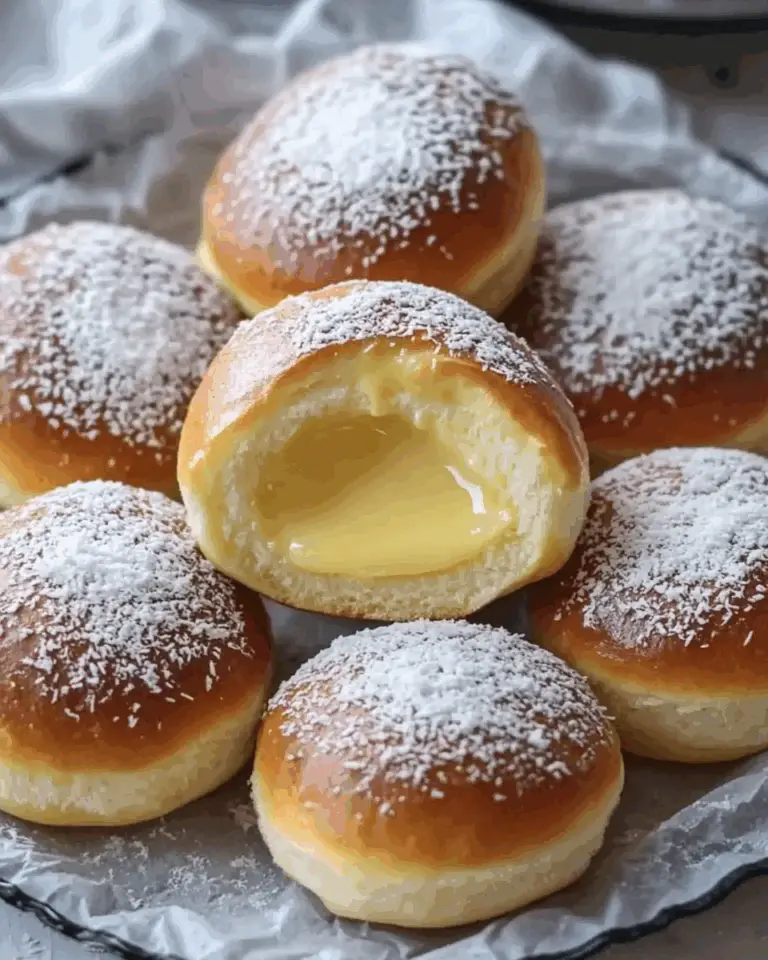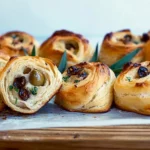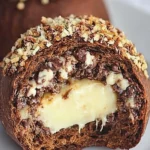The Science Behind the Tangzhong Method
A key factor in the remarkable softness of these custard buns is the tangzhong, or water roux, method. Tangzhong involves cooking a small portion of flour with water until it thickens into a paste before being incorporated into the main dough. This process gelatinizes the starches, which helps the dough retain moisture and stay fresh longer.
The result is a bun with a tender crumb that remains soft for days without drying out. Tangzhong improves the dough’s elasticity and structure, making it easier to knead and shape while also contributing to a lighter texture. This technique, borrowed from Japanese bread making, has become a staple in many soft bread recipes worldwide, especially in Asian and Scandinavian baking.
By including tangzhong, these custard buns transcend the usual softness of standard bread rolls, offering a melt-in-the-mouth experience that feels luxurious yet wholesome.
Flavor and Aroma: Cardamom and Coconut Notes
While the recipe primarily focuses on vanilla custard and soft buns, the subtle influence of cardamom and coconut brings a distinct aromatic quality. Although cardamom is a hallmark of Skoleboller, this recipe achieves a similar warmth through the enriched dough and the custard’s fragrant vanilla.
The light dusting of shredded coconut on top of the buns adds a delicate sweetness and a slight chew that contrasts nicely with the smooth custard inside. Coconut’s tropical aroma complements the vanilla and enhances the sensory appeal of the buns without overwhelming the palate. Together, these elements create a flavor profile that feels both comforting and a little exotic, encouraging repeated enjoyment.
The Custard Filling: Silky and Fragrant
The homemade vanilla custard filling is the star that sets these buns apart from ordinary bread rolls. Crafted to be smooth and silky, the custard is rich without being heavy, delivering a luscious mouthfeel that contrasts wonderfully with the soft bun exterior.
Flavored delicately with vanilla, the custard offers a sweet yet balanced taste that enhances the bread’s mild flavor. The richness of the cream or milk used in the custard adds depth, while the custard’s temperature—chilled before filling—helps maintain the bun’s structure during baking. This filling ensures every bite is moist and flavorful, providing a satisfying indulgence that’s not overly sweet.
Dough Preparation and Kneading
The dough preparation combines traditional bread ingredients with the tangzhong paste to achieve ideal hydration and softness. Using a stand mixer for kneading ensures even development of gluten, producing a dough that is elastic and smooth, qualities necessary for shaping the buns neatly.
The inclusion of milk powder enriches the dough, contributing to tenderness and a slightly sweet flavor. Butter adds richness and a velvety crumb, making the buns more indulgent and moist. The stepwise kneading, beginning with basic mixing and followed by incorporating butter gradually, is essential for developing the dough’s structure without becoming too stiff or greasy.
Proper kneading is key to achieving the “windowpane” effect—a sign of well-developed gluten—which results in buns that rise well and maintain their soft texture.
Shaping and Filling the Buns
Shaping these custard buns involves dividing the dough into uniform portions and forming smooth balls that rise evenly during proofing. Flattening each ball and creating a shallow indent provides a perfect nest for the custard filling, ensuring it stays in place during baking.
Using a glass or similar tool to create a wide but shallow depression in the dough allows the custard to spread evenly without spilling over the edges. This technique guarantees that the custard remains luscious and visible after baking, inviting a beautiful presentation.
The careful spooning of chilled custard into each indent prevents overfilling, which could otherwise cause leakage and sogginess. This attention to detail ensures that the buns bake up perfectly, with a golden crust surrounding a creamy center.
Baking and Finishing Touches
Baking the custard buns at a moderate temperature produces a golden, flaky crust that contrasts nicely with the tender crumb inside. Brushing the buns with milk before baking gives them a subtle sheen and enhances browning, creating an inviting appearance.
After baking, brushing the buns with melted butter adds richness and prevents the crust from drying out, while amplifying the buttery aroma that makes fresh pastries irresistible. The cooling step on a wire rack prevents sogginess, maintaining the buns’ crisp exterior and fluffy interior.
The light dusting of coconut on top adds a decorative and flavorful finish that distinguishes these buns from standard sweet rolls.
Nutritional Overview
Each custard bun provides a moderate amount of calories, making it a satisfying but not overly indulgent treat. The combination of enriched dough and creamy custard offers a balanced source of carbohydrates and fats, with a modest protein contribution from milk and flour.
The use of dairy or plant-based milk in the recipe allows flexibility for dietary preferences. The buns provide a comforting energy boost, suitable for breakfast or a mid-day snack. The fiber content from flour and any natural fruit flavoring in the custard helps support digestion.
Overall, these custard buns fit well into balanced diets when enjoyed in moderation, offering both pleasure and nourishment.
Serving Suggestions
Custard buns are best enjoyed fresh or within a day or two of baking to fully appreciate their softness and creamy filling. They pair wonderfully with a hot cup of tea or coffee, making them an ideal breakfast or afternoon snack.
For a more indulgent experience, they can be served alongside fresh fruit or a light fruit compote to complement the vanilla custard’s sweetness. These buns also travel well, making them a popular choice for picnics or lunchboxes.
Their elegant appearance and inviting aroma make them perfect for gatherings, brunches, or festive occasions where a homemade touch is appreciated.
Conclusion
Easy Custard Buns embody the perfect fusion of soft, fluffy bread and smooth, fragrant vanilla custard. Inspired by traditional Scandinavian pastries, this recipe uses modern baking techniques like tangzhong to achieve exceptional softness and longevity, while the coconut topping and aromatic custard elevate the flavor profile.
The buns’ inviting textures—from the golden, tender crust to the creamy filling—make them a versatile treat suitable for breakfast, snacks, or special occasions. Their simple ingredient list and straightforward preparation mean they are accessible to bakers of all skill levels, yet their sophisticated taste ensures they will impress.
Whether you are seeking a comforting homemade pastry or an elegant dessert, these custard buns provide a delicious solution. Their nostalgic flavors combined with modern baking insights make them a timeless favorite destined to become a staple in your baking repertoire.






